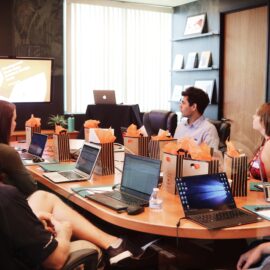

This article gives you a glimpse of what you can learn with Shortform. Shortform has the world’s best guides to 1000+ nonfiction books, plus other resources to help you accelerate your learning.
Want to learn faster and get smarter? Sign up for a free trial here .
Are your employees uninspired and lacking productivity? How can you engage employees in the workplace?
Hard-working employees are the foundation of a successful business. So when employees aren’t engaged in their work or with other workers, the business suffers.
Below you’ll learn how to engage employees and the benefits of stimulating engagement.
What Is Employee Engagement?
In Carrots and Sticks Don’t Work, Paul Marciano distinguishes between motivation and engagement. In his semantics, motivation refers to short-lived, brittle energy influenced by external factors. Remove the factors, and the employee stops working. Motivational energy tends to burn brightly and briefly without leading to permanent habits.
Engagement is an intrinsic, deep-rooted commitment to the job, organization, team, manager, and customer. Engaged employees work hard for the sake of the organization and because they feel fulfilled.
To picture the difference between engagement and motivation, imagine that a team is working to meet a deadline. An equipment failure makes it impossible to meet the goal. Do they keep soldiering on trying to achieve the most, or do they give up?
Engaged employees tend to do the following:
- Bring new ideas to work and suggest improvements
- Take initiative
- Exceed goals and expectations
- Are growth-oriented, seeking to improve the self and people around them
- Encourage and support team members
- Overcome obstacles
- Show high levels of discretionary effort
- Speak with pride about the organization
- Act as though they have ownership in the business
The benefits extend beyond the employee to the organization as well. Studies show that higher engagement is associated with increased profitability, higher customer satisfaction, lower turnover, reduced fraud, and reduced absenteeism.
Unfortunately, studies of employers nationwide show that the majority of American workers are disengaged from their work. They don’t embody the desired qualities above. Clearly, more employers need to help their employees feel more engaged with their work.
4 Tips for Engaging Employees
In When They Win, You Win, employee experience expert Russ Laraway says that poorly trained, ineffective managers may be at fault for low employee engagement. However, there are solutions: managers must develop their leadership skills to greatly improve their team’s morale and performance.
These tips will help managers engage employees and keep them at the top of their game.
1. Encourage Collaboration and Team-Building
Team-building encourages employees to step outside their comfort zone and collaborate with other workers. They’ll not only feel more connected to other employees, but to the organization’s purpose itself. According to Team Topologies by Matthew Skelton and Manuel Pais, there are three main ways your teams should interact with each other: cooperation, guidance, and the consumer-provider model.
Cooperation
The first mode of interaction is cooperation, which occurs when two of your teams come together to work on a shared project. As Skelton and Pais argue, your organization can use cooperation to generate new ideas and ways forward by allowing two teams to work on the same project without having to wait on each other. However, you shouldn’t allow more than two teams to cooperate on a single project. When you bring too many teams onto a project, you increase the amount of time spent coordinating and reduce efficiency overall.
The Consumer-Provider Model
Skelton and Pais’s second mode of interaction is the consumer-provider model. In the consumer-provider model, one team uses a software product provided to them by another team. This model increases efficiency by preventing your teams from wasting time on problems that other teams have already solved. As opposed to cooperation, one team may provide their product to however many of your teams can make use of it, thanks to the low communication requirements of the consumer-provider model.
Guidance
The final mode of interaction Skelton and Pais describe is guidance. Guidance occurs when one of your teams needs assistance, expertise, or knowledge from another team. Your guide team focuses on imparting new skills and knowledge to another team, while the other team attempts to learn new skills they can apply to their projects, thereby increasing productivity and employee engagement.
2. Support Employee Autonomy
The second way you can learn how to engage employees is by embracing autonomy, meaning you give employees control of their own work. Brave New Work by Aaron Dignan’s principle of autonomy is based on the assumption that people are trustworthy, intrinsically motivated, and capable of problem-solving. In a context where leaders expect these qualities in their employees, Dignan believes that employees will fulfill these expectations. On the other hand, if leaders believe that people are extrinsically motivated and need to be micromanaged to do good work, people will also internalize and fulfill these expectations.
Having autonomy means that employees control their work as much as possible. This requires leaders to trust individuals and groups to self-manage and make decisions on their own (or with input from peers as needed) rather than simply following instructions from a higher-up. For example, if someone needs new software to finish the project they’re working on, they should be able to purchase it quickly on their own, rather than asking a superior for permission, filling out request forms, and waiting for approval. This process is time-consuming, costly, and frustrates people who are prevented from doing the important work.
Distribute Authority Widely
For the principles of autonomy and flexibility to be effective in your organization, authority is another important area to reform. In general, Dignan recommends giving people the power to carry out the organization’s purpose the best way they see fit, rather than workers simply following orders from a superior. Regular governance meetings and allocating resources as needed are a couple of specific ways to distribute authority.
A regular governance meeting creates a democratic space for everyone to implement the consent process discussed in the previous section. In these meetings, everyone has the authority to propose changes to structures and processes or to raise concerns about anything inhibiting their work. If your organization already has a lot of meetings, Dignan also recommends canceling all meetings for two weeks to give everyone a chance to figure out what meetings are genuinely helpful. People can then return to the governance meeting with a new perspective on what changes they want to see and what processes they want to maintain.
Since control of resources is another way to exercise authority, allowing workers to allocate resources as needed is another way to distribute authority. Rather than adhering to a rigid, traditional budget that controls the flow of resources, Dignan suggests maximizing discretionary funds and the number of people who have access to them.
3. Help Employees Advance Their Careers
The third focus area for figuring out how to engage employees is career development: helping employees to plan and realize their long-term career goals, not just their current job goals. Notably, this focus area includes helping your workers advance their careers even if doing so means they eventually leave your company.
We’ll examine When They Win, You Win’s suggestion of using three crucial meetings to build the foundation for an employee’s career development. We’ll then discuss how you can gauge your effectiveness in this area.
The Three Meetings
Career development should be an ongoing process with each of your employees. However, to be effective in this focus area, Laraway recommends setting three meetings with each employee, each with a specific focus.
At the first meeting, ask your employee how they got to their current job role. Ask about their past—their education, their previous jobs, and why they applied for their current position. Knowing your employee’s history will give you a more thorough understanding of them as a person, including their interests, shortcomings, and job skills that may not come up in their current position. This understanding will make you better able to help them find and get their dream job.
At the second meeting, ask about their goals and their aspirations. What do they hope to get from their current job? What do they hope to accomplish over the next year? Five years? What’s their ultimate career goal?
At the third meeting, work with the employee to create what Laraway calls a Career Action Plan (CAP). In short, this is a plan to get the employee from their current position to the dream position that they described in the second meeting. What skills will they need to develop? What work experience will they need? How can they accomplish this, and how can you help as their manager?
Career Development: Measuring Your Effectiveness
To find out how effectively you’re helping your workers with their career development, Laraway suggests asking employees to rate you in the following two categories:
1) Constructiveness. Ask: How well does your manager support your career development? How helpful is your manager’s advice about your career? How frequently does your manager encourage you to take on new challenges or learn new skills that may help you in the future?
2) Care. How strongly do you agree with the statement, “My manager cares about me as a human being, not just as an employee?”
4. Create a Psychologically Safe Environment
In The Fearless Organization, Amy C. Edmondson says that leaders must create a safe space to engage employees. In this type of environment, employees feel comfortable asking questions, engaging in debate, and learning from one another. Building psychologically safe work cultures enables workers to tap into their creativity and innovate.
As a leader, you can encourage employees to speak up by asking thoughtful questions and putting structures in place that support your efforts to engage employees. This will bring workers into the fold, inspire them to replicate the behavior you want to embed in your organizational culture, and foster employees’ belief that what they have to say is important.
Employ a Thoughtful Inquiry Process
Asking employees questions can help you learn more about situations and challenges you need to understand to run your organization effectively. To ask thoughtful questions:
1) Ask open-ended questions that provoke deeper thought and further discussion (as opposed to yes/no questions, which tend to shut conversations down).
2) Phrase questions in a way that encourages respondents to give specific answers. For example, if you want a broader understanding of a situation, you might ask: “What aren’t we seeing in this situation?” or “Who has another way of thinking about this?” Or if you want to understand a situation more deeply, you might ask, “Why do you think that?” or “What are some examples of what you’re saying?”
Edmondson says you can also elicit information from employees by creating structures designed to get them to speak up rather than stay silent. For example, schedule regular focus groups to solicit employee input. Alternatively, establish peer-to-peer, inter-team teaching and learning groups to foster inquiry and build knowledge—a structure that comes with the added benefit of increasing trust and decreasing employees’ fear of judgment from members of teams they don’t know.
Respond Thoughtfully When Employees Engage
Edmondson claims that positively reinforcing employees when they engage and speak up encourages them to continue speaking up. This is particularly important in workplaces defined by uncertainty, where workers may encounter negative outcomes even when they do everything right. For example, school teachers may use identical methods to teach two students in the same class, but they may have mixed results due to factors beyond their control, such as the students being in different places developmentally.
To positively reinforce employees for speaking up, listen carefully when they ask questions and share concerns, thank them for their contributions, offer ongoing support, and normalize failure to reduce fears around making and discussing mistakes. Edmondson says that even if you don’t like or agree with workers’ feedback, you should continue to encourage them to speak up, which you can do by saying: “I appreciate you bringing this to my attention.” Your goal is not to love everything they share with you but to consistently communicate that a) you welcome their voices and b) learning is an ongoing process that’s vital to their and the company’s success.
Final Words
Employee engagement is just one of many core business practices. It takes an active leader who genuinely cares about their employees to know how to engage employees. After unlocking your team’s potential, you’ll see a drastic increase in performance that wouldn’t have been possible without these tips.
What are other ways to learn how to engage employees? Let us know in the comments below!

Want to fast-track your learning? With Shortform, you’ll gain insights you won't find anywhere else .
Here's what you’ll get when you sign up for Shortform :
- Complicated ideas explained in simple and concise ways
- Smart analysis that connects what you’re reading to other key concepts
- Writing with zero fluff because we know how important your time is






